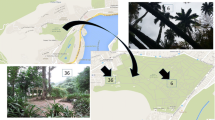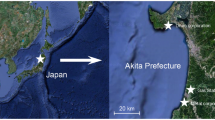Summary
The possibility of selective oxidation of volatile organic compounds in the presence of methane was investigated. Thermal decomposition of a mixture of CH3COONa and NaOH was used as the source of methane introduced into a stream of purified air. Oxidation of the methane present in a stream of air on a layer of the Körbl catalyst is only slight and does not exceed 10%, even in the case of simultaneous presence of acetic acid, which is completely oxidized under identical conditions. Other volatile organic compounds also undergo complete oxidation. It was found that the degree of oxidation of 16 organic compounds is ≥97.5%. The detection limit of the developed method depends primarily on the effective removal of the so-called “carbon background” of the air sample, resulting from the presence of CO2, CO and CH4. The developed method of selective oxidation can be used for specific elimination of the effect of methane on the results of determinations of TOC in volatile air pollutants.
Zusammenfassung
Die Möglichkeit einer selektiven Oxydation flüchtiger organischer Verbindungen neben Methan wurde untersucht. Methan wurde im gereinigten Luftstrom durch thermische Zersetzung eines Gemisches von CH3COONa und NaOH hergestellt. Die Oxydation des Methans im Luftstrom an einer Körbl-Katalysatorschicht ist gering und überschreitet nicht 10%, sogar bei gleichzeitiger Anwesenheit von Essigsäure, welche unter diesen Bedingungen — wie andere flüchtige, organische Verbindungen — vollständig oxydiert wird. An 16 organischen Verbindungen wurde festgestellt, daß der Oxydationsgrad≧97,5% beträgt. Die Erfassungsgrenze der entwickelten Methode zur TOC-Bestimmung ist vor allem von einer effektiven Beseitigung des sogenannten Kohlenstoffblindwertes abhängig, der durch Anwesenheit von CO2, CO und CH4 in der Luftprobe verursacht wird. Das entwickelte, selektive Oxydationsverfahren kann somit zur spezifischen Eliminierung des Einflusses von Methan auf die Bestimmungsresultate des TOC-Gehaltes aus flüchtigen Luftverunreinigungen Anwendung finden.
Similar content being viewed by others
References
M. Haeberle, Chemieunterricht7, 4 (1976).
Ł. Matuszewska, Chem. Anal.17, 1147 (1972).
H. J. Van de Wiel, Meßtech. Autom., Int. Kongr., Kongreßvortr.,52 (1974).
J. A. Giannovario, R. L. Grob, and P. W. Rulol, J. Chromatography121, 285 (1976).
P. Leinster, R. Perry, R. J. Young, Talanta24, 205 (1977).
R. Jeltes, VDI-Ber.270, 75 (1976).
A. A. Siddiqi and F. L. Worley jr., Atmos. Environ.11, 131 (1977).
G. C. Ortman, Analyt. Chemistry38, 644 (1966).
W. H. King jr., Environ. Sci. Technol.4, 1136 (1970).
J. Theer, Chem. Tech. Berl.20, 484 (1968); Analyt. Abstr.18, 617 (1970).
B. Dimitriades and D. E. Seizinger, Environ. Sci. Technol.5, 223 (1971).
D. Siegel, F. Müller, and K. Neuschwander, Chromatographia7, 399 (1974).
J. R. Comberiati, Analyt. Chemistry43, 1497 (1971).
R. W. Freedman and H. W. Lang, Rep. Invest. U. S. Bur. Mines, RI 7179, 1968; Analyt. Abstr.18, 615 (1970).
P. J. Lebel, R. A. Lamontagne, and H. W. Goldstein, Int. Conf. Environ. Sensing Assess. (Proc.)2, 351 (1975).
L. M. Games and J. M. Hayes, Analyt. Chemistry48, 130 (1976).
T. Nakadoi, H. Fujimori, and Y. Yagi, J. Japan Soc. Air Pollut.10, 312 (1975); Analyt. Chern.49, 5R (1977).
D. W. Stevens, ASTM Spec. Tech. Publ.555, 88 (1974).
E. G. Rastjannikov and L. N. Tarasova, Gig. Sanit.1974, 69.
F. Bruner, P. Ciccioli, and F. Di Nardo, J. Chromatography99, 661 (1974).
P. Ciccioli, G. Bertoni, E. Brancaleoni, R. Fratarcangeli, and F. Bruner, J. Chromatography126, 757 (1976).
M. Neuray, W. De Craecker, and J. Stevens, Ann. Mines Belg.5, 389 (1976).
T. Fujii and K. Imamura, Proc. Osaka Environ. Pollut. Contr. Center1, 77 (1975).
J. C. Cooper, H. E. Birdseye, and R. J. Donnelly, Environ. Sci. Technol.8, 671 (1974).
E. Kozłowski and J. Namieśnik, Mikrochim. Acta [Wien]1978 II, 435.
O. Saito, H. Asami, and K. Kawado, J. Japan Soc. Air Pollut.10, 309 (1975); Analyt. Abstr.49, 5R (1977).
W. B. Innés and A. J. Andreatch, Environ. Sci. Technol.4, 143 (1970).
D. A. Mack, C. D. Hollowell, and R. D. McLaughlin, LBL-2099, July 1973.
E. Kozłowski and J. Namiesnik, Mikrochim. Acta [Wien]1978 II, 473.
J. Levée and J. M. Smith, AICHE J.22, 159 (1976).
B. Bobranski, Chemia organiczna, PWN, Warszawa, 1964.
Author information
Authors and Affiliations
Rights and permissions
About this article
Cite this article
Kozlowski, E., Namieśnik, J. Determination of total carbon and total organic carbon from volatile air pollutants. Part III. Mikrochim Acta 71, 1–15 (1979). https://doi.org/10.1007/BF01197515
Received:
Issue Date:
DOI: https://doi.org/10.1007/BF01197515




